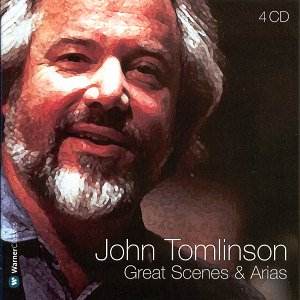|
|
Search MusicWeb Here |
|
 |
||
|
Founder:
Len Mullenger (1942-2025) Editor
in Chief:John Quinn
|
|
|
Search MusicWeb Here |
|
 |
||
|
Founder:
Len Mullenger (1942-2025) Editor
in Chief:John Quinn
|

BUY NOW AmazonUK AmazonUS
|
John Tomlinson: Great
Scenes and Arias CD 1 Wolfgang Amadeus MOZART (1756 – 1791) Don Giovanni Act 1 Scene 1: Notte e giorne faticar; Scene 5: Chi è la?; Madamina, il catalogo è questo; Act 2 Scenes 7-9: Di molte faci il lune; Sola, sola, in buio loco; Dunque, quello sei tu; Ah, pietà, signori miei!; Scene 11: O statua gentilissima Richard WAGNER (1813 – 1883) Das Rheingold Scene 2: Wotan, Gemahl! Erwache!; Um des Gatten Treue besorgt; Scene 4: Weiche, Wotan, weiche!; Abendlich strahlt der Sonne Auge; Ihrem Ende eilen sie zu; Rheingold, Rheingold! Die Walküre act 1 scene 2: Müd am Herd fand ich den Mann; Friedmund darf ich nicht heissen; Aus dem Wald tribe es mich fort; Die so leiding Los die beschied; Ich weiss ein wildes Geschlecht Arnold SCHÖNBERG (1874 – 1951) a Survivor from Warsaw, op 46 CD 2 Wolfgang Amadeus MOZART Così fan tutte Act 1: Son già le sei; Vorrei dir e cor non ho; Stelle! Per carità, signor Alfonso; Dove son?; Soave sia il vento; Non son cattivo comico; Che silenzio: che aspetto di tristezza; Act 2: Ah poveretto me; Tutti accusan le donne Richard WAGNER Die Walküre act 2: Als junger Liebe Lust mir verblich; Ein andres ist’s: achte es wohl; So nimmst du von Siegmund den Sieg?; So nimm meinem Segen, Nibelungen-Sohn; Act 3, Scene 2: Wo ist Brünnhild’, wo die Verbrecherin?; Hier bin ich, Vater; Scene 3: So tatest du, was so gern zu tun ich begehrt; Du zeugtest ein edles Geschlecht; Was hast du erdacht, dass ich erdulde?; Leb wohl, du kühnes, herrliches Kind!; Der Augen leuchtendes Paar; Loge, hör! Lausche hierher! CD 3 Jean-Philippe RAMEAU (1683 – 1764) Naïs Prologue, Scenes 2 and 3: Arrétez, monstres, arrétez; Au fond des gouffres éternels Francesco CAVALLI (1602 – 1676) L’Ercole amante Act 4, Scene 4: Eccoti o Dea contenta Richard WAGNER Siegfried Act 1, Scene 2: Heil dir weiser Schmied!; Jier sitz’ ich am Herd, und setze mein Haupt; Du rührtest dich viel auf der Erde Rücken; Viel, Wanderer, weisst du mir aus der Erde Nabelnest; Viel, Wanderer, weisst du mir von der Erde rauhem Rücken; Fragen und Haupt hast du gelöst; Nun, ehrlicher Zwerg, sag mir zum ersten; Wie doch genau das Geschlecht du mir nennst; Ha ha ha ha! Der witzigste bist du under den Weisen; Dreimal solltest du fragen; Act 2, Scene 1: Wer naht dort schimmernd im Schatten?; Mit mir nicht, hadre mit Mime; Fafner! Fafner! Erwache, Wurm!; Nun, Alberich! Das schlug fehl! Act 3, Scene 1: Wache, Wala! Wala! Erwach!; Stark ruft das Lied; Mein Schlaf ist Träumen; Dir Unweisen ruf’ ich ins Ohr; Scene 2: Dort seh’ ich Siegfried nahn; Was lachst du mir aus? Alter Frager!; Kenntest du mich, kühner Spross CD 4 Wolfgang Amadeus MOZART Le nozze di Figaro Act 1: Cinque; dieci; venti; Cosa stai misurando; Se a caso madama la notte ti chiama; Or bene, ascolta e taci!; Se vuol ballare, signor Contino; Non più andrai farfallone amoroso; Act 4: Tutto è disposto; Aprite un po’ quegl’occhi Richard WAGNER Parsifal Act 1: O wunden-wundervoller heiliger Speer!; Titurel, der fromme Held, der kannt’ ihn wohl; Vom Bade kehrt der König heim; Vervandlungsmusik; Nun achte wohl und lass mich seh’n; Act 3: Heil dir, mein Gast!; Heil mir, dass ich dich wiederfinde!; O Herr! War es ein Fluch, der dich vom rechten Pfad vertrieb; Karfreitagszauber; Du siehst, das ist nicht so; Mittag. Die Stund’ ist da Chor der Sächsischen Staatsoper Dresden and Staatskapelle Dresden/Giuseppe Sinopoli (Schönberg), English Bach Festival Chorus and Orchestra/Nicholas McGegan (Rameau), Michel Corboz (Cavalli), Berliner Philharmoniker/Daniel Barenboim (Mozart), Staatskapelle Berlin/Daniel Barenboim (Die Walküre Act 1; Parsifal), Orchester der Bayreuther Festspiele/Daniel Barenboim (Das Rheingold; Die Walküre Acts 2 and 3; Siegfried) Recorded in All Saints’ Church, Tooting Graveney, January 1980 (Cavalli); EMI Abbey Road Studios, London, in December 1980 (Rameau); Jesus-Christus Kirche, Berlin, 3-12 November 1989 (Così fan tutte); 6-17 May 1990 (Le nozze di Figaro); April 1991 (Don Giovanni); Bayreuth Festival June/July 1991 (Das Rheingold); June/July 1992 (Die Walküre and Siegfried); Deutsche Staatsoper Berlin, 28 November 1993 "Live" (Die Walküre Act 1 Scene 3); Sächsische Staatsoper Dresden, May/June 1998 "Live" (Schönberg) |
Error processing SSI file |
|
|
Return to Index |